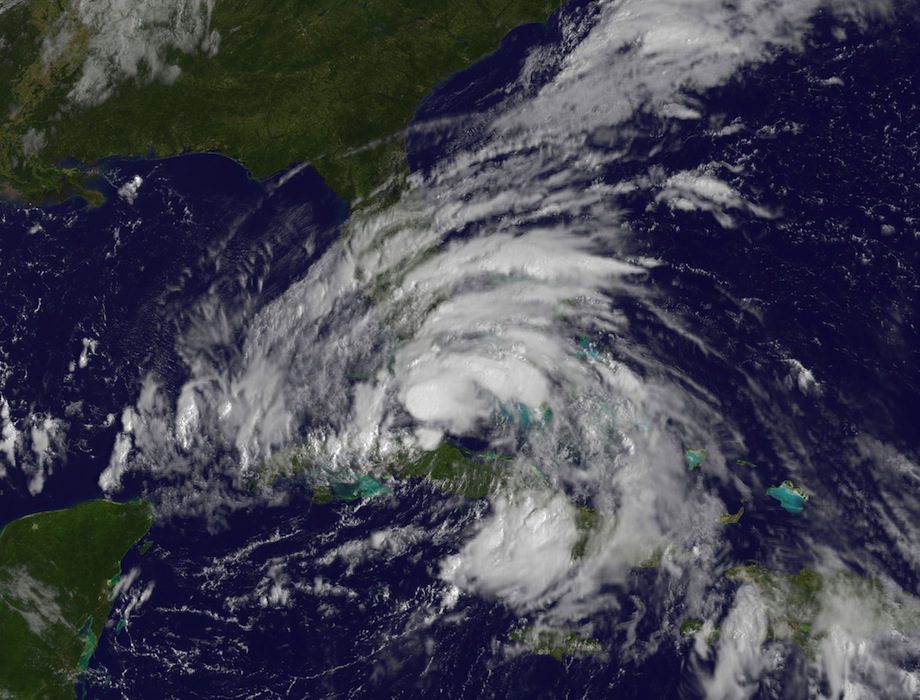his visible image of Tropical Storm Isaac was captured by NOAA’s GOES-13 satellite on Sunday, Aug. 26 at 9:45 a.m. EDT and shows clouds from Tropical Storm Isaac from Cuba to northern Florida. Credit: NASA GOES Project
Editor’s NOTE: With Hurricane Issac threatening a direct hit on New Orleans Wednesday, which happens to be the seventh anniversary of Hurricane Katrina, BSEE provides the following update on the U.S. Gulf of Mexico oil and gas activities.
BSEE – Offshore oil and gas operators in the Gulf of Mexico are evacuating platforms and rigs in the path of Tropical Storm Isaac. The Bureau of Safety and Environmental Enforcement (BSEE) Hurricane Response Team is activated and monitoring the operators’ activities. The team will continue to work with offshore operators and other state and federal agencies until operations return to normal and the storm is no longer a threat to Gulf of Mexico oil and gas activities.
Based on data from offshore operator reports submitted as of 11:30 a.m. CDT today, personnel have been evacuated from a total of 346 production platforms, equivalent to 58.05 percent of the 596 manned platforms in the Gulf of Mexico. Production platforms are the structures located offshore from which oil and natural gas are produced. Unlike drilling rigs, which typically move from location to location, production facilities remain in the same location throughout a project’s duration.
Personnel have been evacuated from 41 rigs, equivalent to 53.9 percent of the 76 rigs currently operating in the Gulf. Rigs can include several types of self-contained offshore drilling facilities including jackup rigs, submersibles and semisubmersibles.
As part of the evacuation process, personnel activate the applicable shut-in procedure, which can frequently be accomplished from a remote location. This involves closing the sub-surface safety valves located below the surface of the ocean floor to prevent the release of oil or gas. During previous hurricane seasons, the shut-in valves functioned 100 percent of the time, efficiently shutting in production from wells on the Outer Continental Shelf and protecting the marine and coastal environments. Shutting-in oil and gas production is a standard procedure conducted by industry for safety and environmental reasons.
From operator reports, it is estimated that approximately 78.02 percent of the current daily oil production in the Gulf of Mexico has been shut-in. It is also estimated that approximately 48.13 percent of the current daily natural gas production in the Gulf of Mexico has been shut-in. The production percentages are calculated using information submitted by offshore operators in daily reports. Shut-in production information included in these reports is based on the amount of oil and gas the operator expected to produce that day. The shut-in production figures therefore are estimates, which BSEE compares to historical production reports to ensure the estimates follow a logical pattern.
After the hurricane has passed, facilities will be inspected. Once all standard checks have been completed, production from undamaged facilities will be brought back on line immediately. Facilities sustaining damage may take longer to bring back on line. BSEE will continue to update the evacuation and shut-in statistics at 1:00 p.m. CDT each day as appropriate
|
Total |
Percentage of GOM |
| Platforms Evacuated |
346 |
58.05% |
| Rigs Evacuated |
41 |
53.9% |
|
Total shut-in |
Percentage of GOM Production |
| Oil, BOPD Shut-in |
1,076,642 |
78.02% |
| Gas, MMCF/D Shut-in |
2,165.94 |
48.13% |
This survey information is reflective of 62 companies’ reports as of 11:30 a.m. CDT today.

 Join The Club
Join The Club











